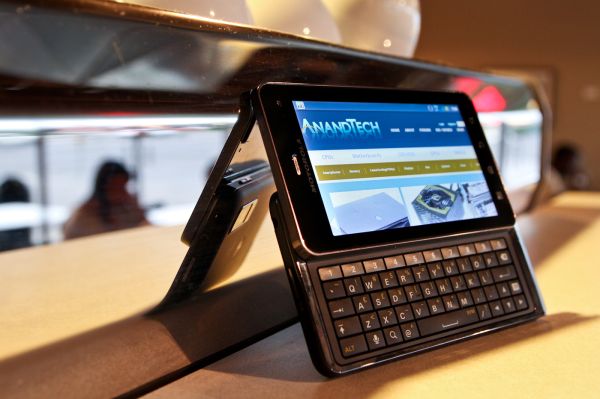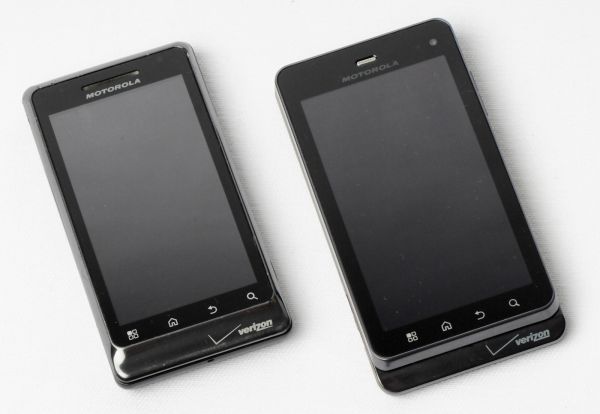Motorola Droid 3 Review - Third Time's a Charm
by Brian Klug on July 30, 2011 12:01 AM ESTIf ever a product has summed up the progression of the Android ecosystem, it’s the Motorola Droid. The first Droid catapulted Android into the mainstream with its first 2.x release, and since then the Droid itself has seen a yearly update cadence that honestly has shown no sign of stopping. The updates thus far track the trends that we’ve seen affect the Android ecosystem as a whole - newer and better versions of Android alongside ever increasing SoC performance, display improvements, camera improvements, and refined hardware design.
I think that pretty much sums up what kind of update the Motorola Droid 3 (henceforth just Droid 3) is. It’s an iterative product launch, for sure, but that belies just how good the improvements all around really are. I noted a few of them already - the Droid 3 includes a dual core OMAP 4430 SoC, larger 4” qHD display, more internal storage, better camera, front facing camera, and most notably a much improved 5 row QWERTY keyboard.
Of course the huge question mark is what has improved connectivity-wise on the Droid 3. There’s no 4G LTE baseband, however, instead of repeating the Droid 2 and Droid 2 Global duopoly, Motorola just went ahead and made the Droid 3 global from the start. That’s right, it’s a dual-mode phone. It’s no consolation if you’re still waiting for an LTE enabled device with a physical keyboard (for that, you’ll have to wait for Samsung to release its rumored next device), but in my mind right now you can either have multi-mode global (CDMA2000 and GSM/UMTS) compatibility or multi-mode (CDMA2000 and LTE) with 4G connectivity. As of yet there’s no having it both ways.
We’ll talk more about all of that in due time, but for now let’s just go over the Droid 3’s outward physical appearance and hardware.
First off, the Droid 3 is notably larger than its predecessor. It’s 3 mm wider, 7 mm taller, but almost 1 mm thinner. Those changes in outline are both to accommodate the 4” screen (as opposed to 3.7”) and likewise the additional keyboard row. Mass is up as well, from 169 to 184 grams. I won’t bore you with all the specifications that have changed, you can just check out the table below.
| Physical Comparison | ||||||
| HTC Thunderbolt | Motorola Droid 2 | Motorola Droid X2 | Motorola Droid 3 | |||
| Height | 122 mm (4.8") | 116.3 mm (4.6") | 126.5 mm (4.98") | 123.3 mm (4.85") | ||
| Width | 67 mm (2.63") | 60.5 mm (2.4") | 65.5 mm (2.58") | 64.1 mm (2.52") | ||
| Depth | 13.2 mm (0.52") | 13.7 mm (0.54") | 9.9 - 14.4 mm (0.39"-0.57") | 12.9 mm (0.51") | ||
| Weight | 183.3 g (6.46 oz) | 169 g (5.9 oz) | 148.8 g (5.25 oz) | 184 g (6.49 oz) | ||
| CPU | 1 GHz MSM8655 45nm Snapdragon | 1 GHz Cortex-A8 OMAP 3620 | 1 GHz Dual Core Cortex-A9 Tegra 2 AP20H | 1 GHz Dual Core Cortex-A9 OMAP 4430 | ||
| GPU | Adreno 205 | PowerVR SGX 530 | ULP GeForce | PowerVR SGX 540 | ||
| RAM | 768 MB LPDDR2 | 512 MB LPDDR2 | 512 MB LPDDR2 | 512 MB LPDDR2 | ||
| NAND | 4 GB NAND with 32 GB microSD Class 4 preinstalled | 8 GB integrated, preinstalled 8 GB microSD | 8 GB NAND, 8 GB microSD class 4 preinstalled | 16 GB NAND, up to 32 GB microSD | ||
| Camera | 8 MP with autofocus and dual LED flash, 720p30 video recording, 1.3 MP front facing | 5 MP with dual LED flash and autofocus | 8 MP with AF/LED Flash, 720p30 video recording | 8 MP with AF/LED Flash, 1080p30 video recording, VGA (0.3MP) front facing | ||
| Screen | 4.3” 800 x 480 LCD-TFT | 3.7" FWVGA 854 x 480 IPS-LCD | 4.3" 960 x 540 RGBW LCD | 4.0" 960 x 540 RGBW LCD | ||
| Battery | Removable 5.18 Whr | Removable 5.2 Whr | Removable 5.65 Whr | Removable 5.65 Whr | ||
Subjectively however, I was shocked at just how thin the Droid 3 feels in the hand in spite of the slide-out keyboard. It seems like generally there’s a certain amount of unacceptable overhead that always comes alongside including an actual keyboard, yet the Droid 3 manages to do it without making it painfully obvious that everything was designed around it instead of with it.
The other major difference is how much different the Droid 3 feels compared to the Droid 2 - entirely as a result of the device using squared edges instead of the rounded chamfers that ringed the Droid 2. There’s been a recent slow march away from rounded industrial design to one dominated by rigid 90 degree angles, and the Droid 3 follows that trend with this move.












84 Comments
View All Comments
anandtech pirate - Sunday, July 31, 2011 - link
hmm, I was thinking about the Sensation vs. Evo3D, one has 768mb of ram while the other has 1GB or ram. The sensation suffers from noticeable lag on the homescreen where as the Evo3D is much smoother. this might be a sense 3.0 problem though as it's a resource hog.themossie - Sunday, July 31, 2011 - link
The extra RAM makes a huge difference when it comes to multitasking.With my Droid 1 the home screen always reloads when I leave an application, and true multitasking is impossible as I can't keep multiple applications in memory.
Droid 1 is significantly hampered by 256 MB. Droid 2 has 512 MB. Droid 3 should have more. Most of the Many competitive phones have 768 MB+ - (offhand the Droid Incredible 2 and MyTouch 4g) or 1 gb (Evo 3D, Atrix 4G) and RAM is cheap...
512 is acceptable now, but don't think in terms of today - what will the minimum requirements be to run Android in 1 year? 2 years?
Reikon - Sunday, July 31, 2011 - link
I was wondering about the Evo 3d review too. Didn't Brian say it was supposed to be out weeks ago?mike8675309 - Tuesday, August 2, 2011 - link
I agree... More memory. The dual core Moto Atrix comes with 1gig of RAM. Verizon has been notoriously stingy with RAM in the phones they deliver.bishless - Saturday, July 30, 2011 - link
I saw "Wetmore" in the maps screenshot and instantly thought, "Holy crap, this writer is in Tucson!"... I looked a little closer and saw Ruthraff and felt proud enough to reveal my detective skills in the article comments... Then a couple pages later, there's the weather widget obviously displaying "Tucson". Heh.So much for detective work.
I see you're aware of Cartel Coffee Lab... we ought to meet for coffee sometime!
Brian Klug - Saturday, July 30, 2011 - link
Yeah, always been here in Tucson ;)I hang out at Cartel a lot, absolutely!
-Brian
GotnoRice - Saturday, July 30, 2011 - link
While having numbers on top is sort of nice, they failed hard when it comes to the most basic element- the orientation of the QWERTY keysLook down at the keyboard right in front of you. The "S" key in the middle row should be directly above the gap between the "Z" and "X" keys. It should straddle the gap between those keys almost perfectly.
Yet on the Droid 3 the "S" key is almost DIRECTLY on top of the "X" key. Simply put, the rows are misaligned.
The reason people like a QWERTY keyboard is because it's a layout they are already familiar. That fact is incompatible with the idea of randomly adjusting the rows in relation to each other as if it's arbitrary; it's not.
They got this mostly right with the Droid 2 keyboard, how did they get it so wrong with the Droid 3?
Pete_ - Saturday, July 30, 2011 - link
Check your facts: the Tegra 2 chipset does not support LPDDR2 (333/266 MHz) and is limited to only 133 MHz DDR. I've owned the DX2 and returned it for the Droid 3... proof is in the pudding.Brian Klug - Saturday, July 30, 2011 - link
Hmm, I'm not sure about that: http://www.nvidia.com/object/tegra-2.html then look under Memory Frequency.We've independently confirmed a few times them using LPDDR2-600, for example on the Optimus 2X.
ol1bit - Saturday, July 30, 2011 - link
I'm glad you posted so many photos, but the blue tint on the flash enabled photo is terrible.Even the video has a tad of blue tint compared with the Cannon.
I wonder if they will do an update to fix that with this phone, or if this is just a jump step phone with no marketing, just to keep money flowing in till the Bionic comes out?